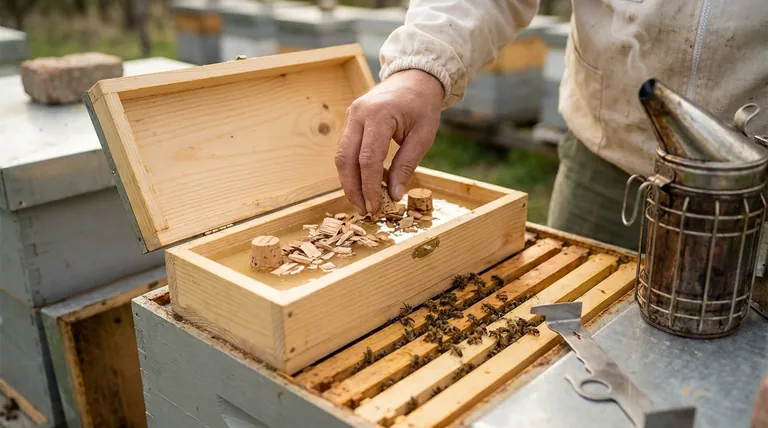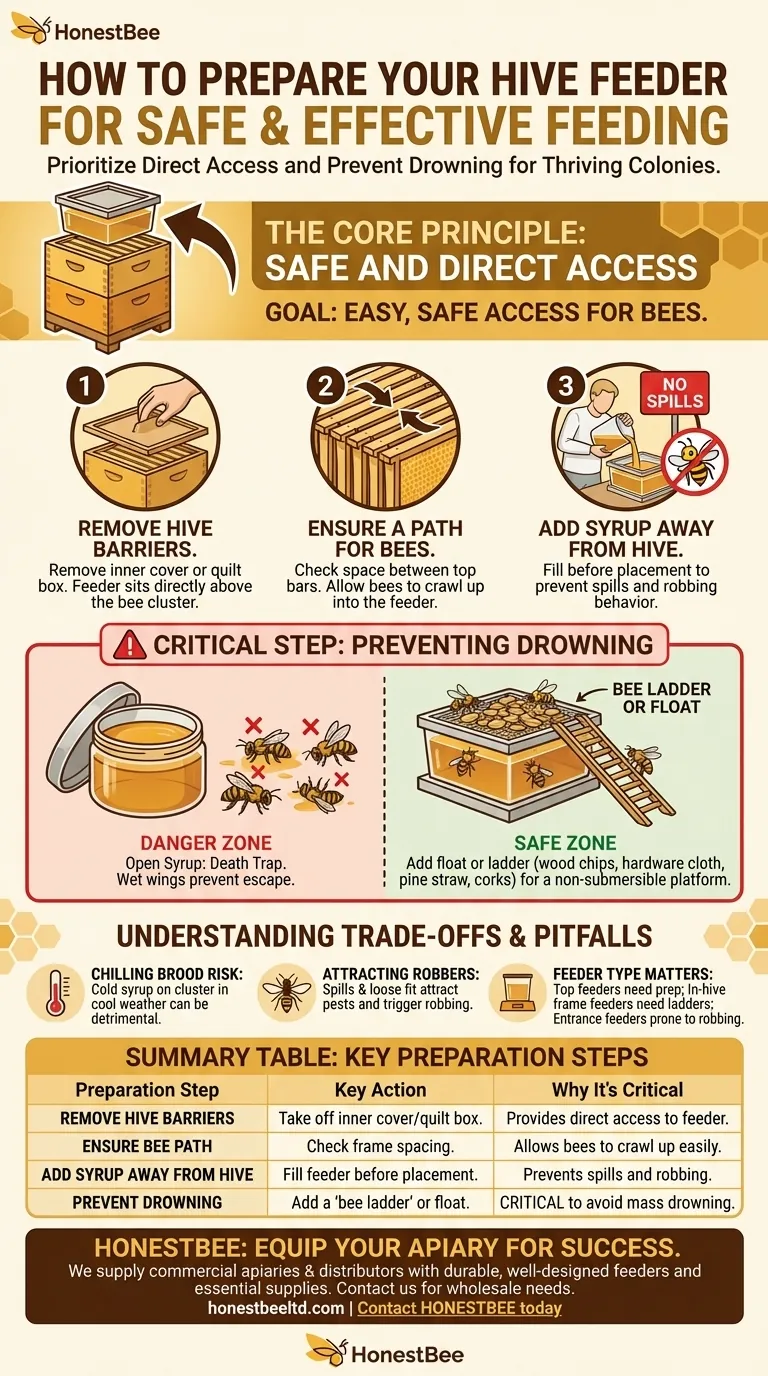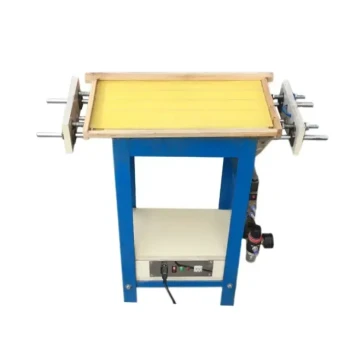To prepare a feeder for your hive, you must first provide the bees with direct access to it and, critically, ensure they cannot drown in the syrup. This involves removing any inner cover that acts as a barrier and adding a float or ladder to the feed so bees have a safe way to get in and out.
The most common and costly mistake in feeding is not the type of syrup used, but the failure to provide a "bee ladder." A well-prepared feeder prioritizes safe access above all else, preventing the unnecessary loss of the very bees you are trying to help.

The Core Principle: Safe and Direct Access
Your goal is to make it as easy and safe as possible for the bees to find and consume the food. This requires removing physical barriers and mitigating the primary danger of any liquid feed: drowning.
Step 1: Remove Hive Barriers
The feeder, especially a top feeder, must sit directly above the bee cluster.
Any inner cover or quilt box must be removed. These items create a ceiling that blocks bees from reaching the feeder you are about to place on top of the hive box.
Step 2: Ensure a Path for the Bees
The bees need a way to crawl up from their frames into the feeder.
Check that the top bars of the frames have sufficient space between them for bees to pass through. Most standard spacing allows this, but if your frames are pressed tightly together, you may need to create a small gap.
Step 3: Add the Syrup
Fill the feeder with your prepared sugar syrup before placing it on the hive. Doing this away from the colony helps prevent spills that can excite bees and trigger robbing behavior from nearby hives.
The Critical Step: Preventing Drowning
A simple, open container of syrup is a death trap for honeybees. Once their wings get wet, they cannot fly out and will quickly drown.
Why Drowning Is a Major Risk
Bees are drawn to the scent and will often fall into the syrup in their eagerness to feed. A feeder without safeguards can kill hundreds or even thousands of foragers in a single day, defeating the entire purpose of feeding.
Create "Bee Ladders" or Floats
You must provide a non-submersible platform for bees to stand on. This can be achieved easily and cheaply.
Common materials for bee ladders include hardware cloth (wire mesh) cut to size, clean wood chips, pine straw, or even wine corks. Anything that floats and creates a rough surface for bees to grip will work.
Use Feeders with Built-in Safeguards
Many modern top feeders are designed with this risk in mind. They often have a central chamber where the bees can come up, separated from the syrup reservoirs by plastic walls with textured surfaces that allow the bees to climb down to the feed safely.
Understanding the Trade-offs and Pitfalls
Different situations call for different considerations. Preparing a feeder is not just about the physical setup, but also about understanding the consequences.
Feeder Type Dictates Preparation
The advice above applies primarily to top feeders. An in-hive frame feeder replaces a frame inside the brood box and usually requires a float or ladder. An entrance feeder is placed at the hive entrance and requires no internal hive preparation, but it is highly susceptible to robbing by other insects.
The Risk of Chilling the Brood
Placing a large, cold volume of syrup directly on top of the cluster in cool weather can act as a heat sink. It forces the colony to expend more energy to keep the brood warm. In a weak hive or cold snap, this can be detrimental.
Attracting Robbers and Pests
Any spilled syrup or a feeder that doesn't fit securely can attract ants, wasps, and bees from other colonies. This "robbing" can lead to a frenzy that can overwhelm and destroy a weak hive. Always ensure the outer cover fits snugly over the feeder to create a seal.
A Simple Pre-Flight Checklist for Your Feeder
Before you walk to the hive, review these key points to ensure a successful feeding.
- If you are using any open-reservoir feeder: Your primary action is to add a bee ladder or float to prevent drowning.
- If you are placing a feeder on top of the hive: Your primary action is to remove the inner cover so bees can access the feed.
- If you are feeding in cool weather (below 50°F / 10°C): Consider using an internal frame feeder to minimize heat loss from the cluster.
- If you are concerned about robbing: Ensure the outer cover fits tightly over the feeder and immediately clean up any external spills.
Properly preparing your feeder is a simple but fundamental act of responsible beekeeping.
Summary Table:
| Preparation Step | Key Action | Why It's Critical |
|---|---|---|
| Remove Hive Barriers | Take off the inner cover or quilt box. | Provides direct access for bees to reach the feeder from the brood box. |
| Ensure Bee Path | Check for space between top bars of frames. | Allows bees to crawl up into the feeder easily. |
| Add Syrup Away from Hive | Fill the feeder before placing it on the hive. | Prevents spills that can excite bees and trigger robbing. |
| Prevent Drowning | Add a 'bee ladder' (e.g., wood chips, hardware cloth) or use a float. | Critical to avoid mass drowning of foragers in the syrup. |
Ensure your apiary's success with the right equipment. Proper feeding is fundamental to colony health and honey production. HONESTBEE supplies commercial apiaries and beekeeping equipment distributors with durable, well-designed feeders and essential supplies through our wholesale-focused operations. Let us help you equip your operation for maximum efficiency and bee safety.
Contact HONESTBEE today to discuss your wholesale needs and discover how our products support thriving colonies.
Visual Guide

Related Products
- HONESTBEE Advanced Ergonomic Stainless Steel Hive Tool for Beekeeping
- Professional Dual-End Stainless Steel Hive Tool for Beekeeping
- Rapid Bee Feeder White Plastic 2L Round Top Feeder for 8 or 10-Frame Bee Hives
- Professional 3-Bar Frame Grip with Integrated Hive Tool
- Yellow Plastic Bucket Pail Perch for Beekeeping
People Also Ask
- What tools are used for cleaning frames? A Beekeeper's Simple 4-Tool Guide
- What are the basic tools for beekeeping? Essential Starter Kit for Safe & Successful Hive Management
- What are the features of a regular hive tool? The Essential Multi-Tool for Every Beekeeper
- What are some common uses of a hive tool? Essential Multi-Purpose Tool for Every Beekeeper
- Why do hive tools have a hole? Unlock the Secret to Efficient Beekeeping



















